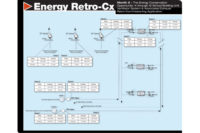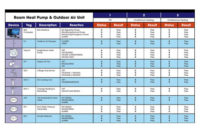Data collection: Auditing HVAC such as this test’s four-pipe HVAC system that consists primarily of unit ventilators with three-way automatic control valves (ATC) requires the following steps.
• Review existing record drawings and create a system flow diagram to document and create a visual survey aid for the HVAC system.
• Inventory automatic control valves to identify three-way control valve quantity.
• Inventory heating and cooling pumps for pump head and pump horsepower noting the discharge balancing valve setpoint (e.g., 30% closed) for potential wasted motor hp. A rule of thumb for heating system pump head is usually around 45 ft total head, and around 60 ft for unit ventilator cooling systems.
• Based on the audit, consider completing a hydraulic model of the heating and/or cooling water systems to determine a more realistic total pump head using TACO LoadMatch® or HVAC Solutions Pro software programs.
• Document the heating and cooling automatic temperature control strategy and compare with system flow diagrams to assess if system is currently operating per the design intent.
Basis of design (BofD) document: The BofD document (refer to “The Facility Files” for an example), should be created to identify the HVAC system’s BofD along with the proposed BofD data resulting from this energy retrocommissioning study. For this B2B series herein, we have completed the energy audit portion of this energy retrocommissioning report based on the October 2011 “The Facility Files” example.
HVAC ENERGY AUDIT RESULTS
For this B2B series, we are going to focus on a school with four-pipe unit ventilators (1,200 cfm each) and associated classroom exhaust systems (600 cfm each) as our energy retrocommissioning candidate. Based on the audit, the following ECM’s will be considered:
• Close off the individual unit ventilator outdoor air dampers and replace with a more efficient direct outdoor air system (DOAS) with energy recovery coils.
• Add new 100% outdoor air system with heating, cooling, energy recovery, and more efficient air filtration of outdoor air.
• Add energy recovery coils and filters to associated room exhaust fans.
• Retrofit the unit ventilator ATC to 100% recirculated room air.
• Replace three-way valves with two-way valves and VFD pumping.
• Add occupancy sensors to classrooms.
• Replace antiquated pump motors with high-efficiency motors.
• Resize heating and cooling pumps using hydraulic modeling of existing water systems.
This month’s test requires the energy auditors to document the existing system flow diagram, review the ATC sequence of operation, mode-by-mode on page two of this B2B. The existing ATC sequence will then be inputted into the functional performance test (FPT) retrocommissioning Cx-3 software, with the “reaction” device-by-device imbedded into the checklist below the flow diagram. The auditors, working with the school’s ATC operator, check each sequence to confirm each control device “passes” the specific ATC reaction to verify the existing system ATC/FPT is operating per the original design intent. The answers can be found at www.esmagazine.com. The sequences selected are Off-Fail Safe Conditions, On-Maximum Cooling, and On-Maximum Heating for this B2B test, but there will be other sequences of operation plus verification of alarms and safeties to be confirmed (not part of this B2B test).
When the energy auditors and the ATC technician have completed the ATC/FPT process, all deficiencies (fail) will have automatically been inventoried into the Cx-3 software’s Corrective Action Log requiring further action by the technician for those failed reactions.
ATC DATA ANALYSIS
After completing the initial ATC/FPT process, the energy auditors will begin the data analysis, solution planning, and completion of the energy retrocommissioning report outlining the various ECM opportunities. With each ECM will be an estimated energy savings, operating cost savings, ROI, and carbon footprint reduction. This report will then be presented and discussed with the school’s energy conservation committee, facility manager, ATC technician, energy auditor/retrocommissioning engineer, energy auditor/testing, adjusting, and balancing (TAB) engineer. If pursuing LEED® EB (existing building), a LEED Accredited Professional will be required to be part of the energy conservation committee.
COMPLETING THE AUDIT AND NEXT STEPS
Based on the data collected and the data analysis, here are some possible next steps:
• Everything is fine. Nothing more to do.
• Need to document an energy retrocommissioning solution plan.
• Need to estimate the retrofit cost to implement an energy retrocommissioning initiative and ROI if needed to fund the project.
• Need to establish a project timeline to implement this energy retrocommissioning initiative.
• Need to implement all “Quick-Fix” and “Low Cost-No Cost” opportunities such as simply changing a control setting that will save energy (Note: all these easy changes still need to be documented as energy retrocommissioning opportunities so that these corrective measures are not missed in the energy retrocommissioning process).
• Need to establish a means to measure energy retrocommissioning results versus existing performance.
Note: Not included in this B2B series is the issue of antiquated chillers and boilers.
Energy Retro-Cx
Month 1-The Energy Conservation Opportunity: K-12 School Building Unit Ventilator System Application — Data Collection







